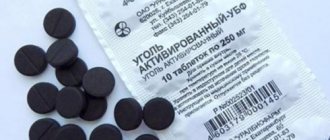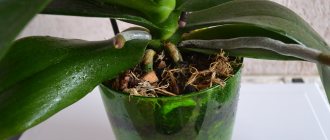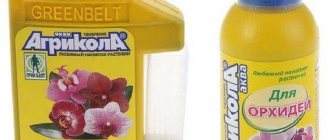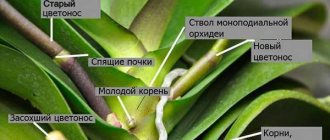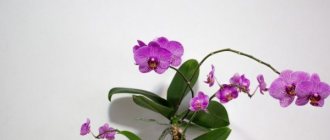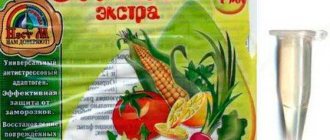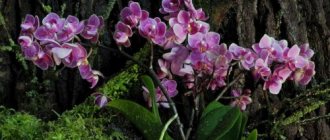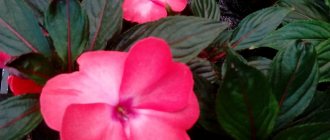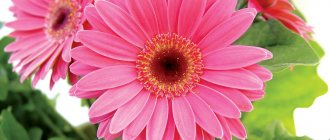Growing orchids at home is not such a difficult task if you take into account the characteristics of their natural growth and provide the necessary care.
The main task when growing epiphytes is the correct selection of soil - substrate.
High-quality composition and
correctly selected components will provide your delicate tropical pet with a favorable environment for full development and growth. Based on the recommendations of orchid growers, we will try to briefly describe the most preferred, ready-made soils. The article will give a description and reviews of different soils for orchids: what are their advantages and disadvantages.
Purchased soils for orchids
Advantages and disadvantages
Advantages of purchased substrate:
- Various packaging;
- Lightness and increased moisture capacity;
There are many different soils for orchids. - Contents of all necessary micro and macroelements;
- Wide selection for different types.
The disadvantages include:
- It is possible that the composition contains peat, which affects the acidity of the soil;
- Lack of NPK composition;
- Irresponsible manufacturer.
Where can I buy it?
To avoid falling for a fake or an irresponsible manufacturer (seller), purchases should be made in specialized flower centers and stores that have a license and certificates for the products.
Imported or domestic?
Whether the manufacturer is foreign or domestic does not play a big role. Companies that produce soil for orchids, both foreign and domestic, have a reputation among flower growers. A reputation is built over years of quality work.
The difference can only be in price and not depending on the quality of the substrate, but in customs duties or logistics. Prices vary depending on :
- Manufacturer's reputation;
- Packaging;
- Substrate components;
- Or a seller.
Which is better?
- By cost . Looking at the price-quality ratio, we can name the best options: Bio Effect, First Aid, Flower Happiness.
- By composition . All substrates (with the exception of Veltorf) are universal in composition and suitable for all varieties of orchids.
A properly selected substrate will allow you to grow a beautiful and strong plant to the delight of the owner. Take an interest in the opinions of experts, visit exhibitions and forums, read specialized literature, and the problem of choice will fade into the background. If a florist spares no effort and money for his orchid, then she will not spare him her flowering.
"Garden of Miracles"
Nutrient soil “Garden of Miracles” is produced by the leader of the Russian soil market, ZAO MNPP Fart.
most varieties of orchids at home :
- Phalaenopsis;
- Oncidiums;
- Dendrobiums;
- Cattleya and others.
Marked by the manufacturer:
- Soil sterility;
- Absence of pathogenic flora and fauna in the components;
- The content of micro- and macroelements is sufficient for the development of an orchid in the first month after planting;
- Has good moisture absorption and breathability;
- Significantly improves the development and growth of transplanted plants.
Important! Requires additional drainage.
In the manufacture of a higher quality substrate it can be one of the components. For better moisture retention, the composition includes long-fiber screening of high-moor peat of large fractions. There is also the presence of limestone flour and other minerals.
The substrate “Garden of Miracles” is one of the leaders on the Russian market.
Nutrients included:
- Nitrogen (NH4 + NO3) – 50 mg/l;
- Phosphorus (P2O5) – 100 mg/l;
- Potassium (K2O) - 100 mg/l;
- pH of the salt suspension – not less than 5.5;
- The mass fraction of moisture does not exceed 70%.
Reviews
Veronica. “Not a bad Fart Miracle Garden substrate, with the exception of too large (in my opinion) bark fractions. It is quite difficult for a woman to grind such a component. Of the domestic soils, it is the most decent. A little modification is required in terms of softening the peat and adding some components. I add coconut flakes and my friend adds perlite. It absorbs and retains moisture well, which is very important in the hot summer months.”
Igor. “I have been using the Garden of Miracles primer for a long time. About 5 years ago its composition was much better. Now we have to add something. Even the required composition of the bark is not always enough for a flower pot. It may be a fake, although the seller denies this in every possible way. I don’t really like the presence of peat in the composition, which softens very hard when it dries out and in general does not appeal to epiphytes.”
"Flower Happiness"
Ready-made “Flower Happiness” substrate with a full set of necessary components. Suitable for almost all orchid epiphytes grown at home.
Components:
- Larch bark;
- Charcoal;
- Expanded clay for drainage.
Manufacturers recommend adding pine bark to the composition .
According to the manufacturer's recommendations, the composition provides a good water-air process that affects the development of the plant. The selection of components and their percentage ratio to each other contributes to the full flowering, growth and health of orchids.
Reviews
Christina. “I’ve been working with orchids for quite a long time, so I know something about substrates. When I first saw ready-made orchid soil “Flower Happiness” on sale, I decided to try it on my flower, which just needed replanting. The impression of the soil is negative. It’s either a fake or a similar batch, but I won’t buy this kind of soil again. Too much garbage, earth and expanded clay. You have to add bark. And a volume of 2 kg is not enough for an adult orchid.”
Substrate "Flower happiness".
Anna. “Why buy soil that needs to be improved. If you remove expanded clay and part of the peat from it and add the normal fraction of pine bark, you will get a good composition. Of course, the bucket is beautiful and convenient, but the substrate is not stored in it for long. Doubts have crept in about the safety of such a product. The packaging says hazard class 3!!! The expanded clay included in the composition is very fine. It’s already undesirable to use it for orchids, and even less so if it’s small. I didn’t like the soil at all.”
Important! The soil needs improvement.
Soil composition
Desirable soil components for orchids are:
- charcoal;
- bark (coniferous or deciduous trees);
- expanded clay;
- coir;
- peat;
- fern roots;
- sphagnum;
- polystyrene;
- vermiculite;
- Pine cones;
- humus.
"Fasco"
“Fasco” is not much different from “Flower Happiness”. The bucket has the signature “Flower Happiness” and it is not entirely clear whether this is simply a coincidence with the name of the previous soil described above, or whether this is the same soil.
The manufacturer of soil mixtures produces both types of soils . The difference is the addition of high-moor peat to the composition.
A significant drawback is the lack of nutrients included in the composition , which have such a remarkable effect on the development and growth of orchids planted in such a substrate.
Specialized soil is suitable for most varieties of orchids, including varieties :
- Phalaenopsis;
- Cattleya;
- Cymbidium;
- Miltoniopsis;
- Dendrobium;
- Paphiopedilum and others.
Reviews
Maria. “I believe that the main component in ready-made substrates for epiphytes should be bark. Unfortunately, this is not the case at Fasco. You have to buy the most important component. And so, a good soil for phalaenopsis. I have not yet tried to grow other types of orchids. According to a neighbor who has been growing orchids for many years, the composition of “Fasco” is quite acceptable, with minor modifications it is a good mixture and a price affordable for many gardeners.”
Sofia. “I grow phalaenopsis and have tried different ready-made types of substrates for epiphytes. I even tried to prepare the composition myself. On the advice of my sister, I purchased ready-made primer from Fasco in a bucket. Very convenient packaging, both in terms of packaging and volume (just enough for a flowerpot). The instructions clearly indicate everything about the transplantation process.
The composition of the Fasco Flower soil does not include bark.
It is recommended to add pine bark, but I did not do this. Orchids also feel great in this composition. With a large number of plants in the house, the price is decent, everyone can afford such a nutritious mixture.”
Precautionary measures
To avoid accidents and feed the plant with maximum benefit, you must follow the following precautions:
- Fertilize only with elastic gloves.
- After completing the manipulations, wash your hands with soap and wash your face with running water.
- Fasco should not be used after the expiration date.
- The bottle should be stored in a cool, dark place, protected from direct sunlight.
- Fertilizer is kept in a place inaccessible to animals and children.
"Peter Peat"
According to the manufacturer, Peter Peat soil is considered a ready-made nutrient for many types of orchids and epiphytes. Provides water-air balance. The selected mixture promotes rapid establishment of the plant and full development.
Compound:
- High and lowland peat;
- Pine bark in the form of mulch;
- Limestone flour;
- Complex fertilizer.
Content of essential nutrients NPK:
- Nitrogen (NH4 + NO3) – 120 mg/l;
- Phosphorus (P2O5) – 100 mg/l;
- Potassium (K2O) - 100 mg/l;
- pH of the salt suspension – not less than 5.5;
- The mass fraction of moisture does not exceed 65%.
The hazard class of this soil is 4. The opinions of flower growers on “Peter Peat” vary greatly. The low price captivates .
Advice! Buy only from a real manufacturer.
Reviews
Anastasia. “I have been growing home flowers all my life. I purchased various soil mixtures not by name, but by composition. About 3 years ago I purchased ready-made soil in a 2-liter yellow bag containing peat. It remained unclaimed and lay on the balcony all these years. While replanting a white orchid (the deadline was approaching), I discovered that there was no ready-made substrate available, and there was only this yellow bag on the balcony. Fortunately, it had the inscription “For orchids” on it.
Having opened it, I was amazed by the contents: pebbles, pieces of bark, some kind of earth (apparently peat). Of course, I was very upset, but still decided to try the transplant.
To my surprise, after a year the roots did not enter the container, and in the spring the orha blossomed very profusely. Apparently the nutrients included are truly nutritious.
True, such contents had to be very carefully monitored for humidity. Watered very rarely. Particular attention when watering in the spring, after awakening and during the flowering period.”
Daria. “I don’t understand why peat mixtures and soils are produced and used for epiphytes. Epiphytes, especially orchids, do not like peat. After reading positive reviews about this soil, I decided to take a chance and replant the orchid, which had not bloomed for more than 2.5 years. And a miracle!!! Six months later it bloomed and began to grow well. Now we have to think about transplanting the remaining orchids. Should I take a risk or should I buy a normal (ordinary) substrate?”
"Pokon"
"Pokon" is one of the positively characterized soils for orchids, with the exception of the high price .
A properly selected composition ensures the maintenance of water and air balance , which ensures the health of the root system and the entire plant as a whole.
The composition consists of natural derivatives:
- Tree bark "Excellent";
- Lime;
- Complex fertilizers.
The nutrient content is designed for 2 months after planting, which is quite enough for good survival , the beginning of full development and growth.
The manufacturer is a Dutch company , which guarantees that this nutrient soil meets all the requirements of the independent Dutch RHP standard.
According to flower growers, one of the disadvantages can be considered 5 liter packaging , which affects the high price of the product.
Reviews
Alexander. “I think that Pokon is not entirely suitable for beginners who want to grow orchids at home. It is necessary to strictly monitor watering and air permeability of the root system, for which they have absolutely no experience or skills. For experienced gardeners, such a nutrient mixture will not be difficult. My orchs thrive in this soil, thanks to my skills in growing exotic epiphytes. Some manufacturer's recommendations are not always effective for growing.
This is especially true for soil compaction during replanting. I rarely compact it. My opinion on the nutritional value and reviews is positive. The number of orchids I grow corresponds to the packaging.”
Victoria. “Compared to domestic soils, it is of course expensive and bulky, but the impression is much better. Although the neighbor doesn't like it at all. Of course it’s expensive, but for my beauties it’s not a pity. They feel and grow beautifully. After domestic soil, they practically do not enter the dormant stage. They bloom magnificently and for a long time. No shortcomings were noticed."
Special cases
For epiphytic plants, there are alternative growing methods - without soil. Epiphytes can be grown in water, on blocks, in glass without water, in polystyrene foam.
Planting and growing in expanded clay
Expanded clay is a light and porous material obtained by firing clay purified from salts, it is biologically inert and does not emit harmful compounds. Expanded clay with a granule size of 8-16 mm is the best substrate for hydroculture of orchids.
For growing in expanded clay, transparent plastic pots with holes in the walls are used.
The holes should be located no closer than 1.5-2 cm from the solid bottom. Such pots provide the roots with drainage, aeration and sufficient light.
The following grow successfully on expanded clay:
- cymbidium;
- paphiopedilum;
- dendrobium;
- Phragmipedium;
- Cattleya;
- phalaenopsis;
- Wanda.
Before planting the plant, it is necessary to soak the expanded clay in water for two to three days at a temperature not lower than 20°C.
Then:
- Place a 2-3 cm layer of substrate on the bottom of the pot.
- Place the orchid's root system in the pot.
- Fill the space between the roots and the walls of the pot with expanded clay, working very carefully and not too hard.
- After two or three waterings, if the expanded clay settles, add expanded clay.
The video shows how to plant a flower in expanded clay:
Read about other options for growing plants without soil here.
"Veltorf"
Ready-made nutrient soil "Veltorf" for orchids. It will be true to say that this is a peat mixture, since such a mixture is produced by a peat processing plant .
In any instructions and recommendations for growing orchids, peat harms the development of epiphytes. But mainly this applies to beginners in floriculture. More experienced orchid keepers understand the process of watering and care when the composition includes some amount of peat.
The nutritional composition ensures the full cultivation and reproduction of orchids. It is used for transplanting or transshipment of plants. Can be used as fertilizer or mulch .
Compound:
- A mixture of weakly and strongly decomposed peat in a 1:1 ratio;
- Pine bark;
- Limestone materials;
- Complex fertilizers.
Nutrient content:
- Nitrogen (NH4 + NO3) – from 150 to 200 mg/l;
- Phosphorus (P2O5) – from 200 to 350 mg/l;
- Potassium (K2O) – from 300 to 500 mg/l;
- The total moisture content does not exceed 65%;
- The pH of the salt suspension is from 5 to 6.
Packaging from the manufacturer is usually 5 liters or 1.5 kg .
Important! Pay special attention to proper watering.
Reviews
Pauline. “I didn’t buy it specifically for growing my phalaenopsis. I just bought it after seeing a new soil for myself. After some time I had to apply it. It is safe to say that this composition is not suitable as the main substrate. The bulk is peat, there is bark and some small sticks and stones. You cannot raise children in it due to the large voids in the root part. Peat is not for orchids.
I liked using it when transshipment, as a small layer of mulch or as a nutritional supplement. The general attitude towards him is neutral.”
Elizabeth. “I purchased this soil a couple of years ago and was disappointed with the contents. Dense pieces of peat and bark. The rest is dry crumbly peat and small wooden debris. The packaging contains instructions for its use, but I was afraid to use this composition for my tropical beauties. I just poured it into the garden under other flowers.”
"Ambulance"
Like many nutrient substrates, it has mixed reviews and recommendations . Is this due to poor quality of the manufacturer or counterfeits? But, if you manage to purchase a high-quality batch, the grower will not be disappointed. The popularity of "Emergency" is above average.
The nutrient substrate is suitable for all types of orchids. Created based on :
- High peat;
- Plus tree bark (pine).
The advantages , according to the manufacturer, include:
- Provides a good microclimate inside the flower container;
- It has a good effect on the survival rate of the plant after transplantation;
- Provides resistance to diseases, stress and improves immunity;
- Helps improve decorativeness;
- Removes the harmful effects of fertilizers and other soil substrates;
- It has a good effect on the development of beneficial microflora and also helps eliminate harmful ones.
The manufacturer guarantees :
- Cleanliness;
- Naturalness;
- And the safety of the composition.
Contains a complete set of micro and macroelements necessary for the full development and growth of orchids.
Advice! It is better to use it as a component when making your own substrate.
Reviews
Sergey. “I have been using only this ready-made substrate for many years and it does not cause me any complaints. My orchids feel great in it: they don’t get sick, they develop well, and most importantly, they bloom long and luxuriantly.
"Ambulance" is a very good substrate and absorbs moisture well.
In the winter, I water them once a week; the soil absorbs moisture well and dries out completely in 7 days. This means that it has good water absorption and breathability qualities. In summer I mainly use the sprinkling method.
Another important factor is the low price and quite convenient packaging, designed for about 2-2.5 flower pots.”
Ksenia. “Before purchasing this nutritional mixture, I read a lot of reviews, but was still undecided about the quality of the composition. I had to try it myself, since the price is low. To be honest, I'm disappointed with the content. I have been growing orchids for many years and I know from experience that for full development and growth, the ratio of bark and other components should be 80 to 20 percent. The “Ambulance” composition is 50/50. Plus there is too much debris (sticks, chips, roots, etc.), a thick fraction of bark, which was apparently made from the butt of a tree. Disappointed with this substrate."
The importance of making the right choice
The soil is selected taking into account the place where the orchid originally grew . Phalenposis, for example, lives in trees, so a special substrate is selected for it: it allows air and water to pass through to the maximum.
But Cymbidium, growing on the ground, requires the inclusion of nutritional supplements in its diet. The owner of an orchid can prepare a good substrate on his own by looking at a couple of recipes. This is perhaps the best option: firstly, there is an opportunity to experiment with store-bought mixtures, and secondly, to drive away boredom and laziness.
"Compo sana"
"Compo sana" is a rather expensive nutritional mixture from Germany. The main component is milled high-moor peat. Also added:
- Bark;
- Lime materials;
- And fertilizers in the form of useful additives.
Like most peat-based nutritional mixtures, it raises many questions. According to experienced orchid growers, it is more suitable as an additive to a self-prepared substrate.
IMPORTANT! The price does not match the content.
Reviews
Alyona. “I purchased this substrate about 3 years ago and had to throw it away. Too much peat, debris, etc. Not at all suitable for growing orchids. This year I saw the same soil at my sister’s and couldn’t believe my eyes. Either they began to produce a better quality product, or at that time I ran into a fake from an unscrupulous manufacturer. I bought it at the same store as my sister. Excellent composition: peat, pine bark and even, in my opinion, there is moss (something fibrous). I replanted my pods and they are doing great. You just need to carefully monitor watering, the substrate takes a long time to dry out.”
Margarita. “I have bought Compo sana more than once. But not as the main soil, but as an additive. I really like how orchids feel after adding this nutrient mixture. No fertilizer required.
Compo sana substrate is most often used as an additive for base soil.
It is also good to use this soil mixture when transferring it to a new container. The root remains in the old substrate, and “Compo sana” is placed on the sides of the container. There are enough nutrients for a couple of months.”
Important! When replanting, strictly follow the instructions on the package.
"EffectBio"
Gaining popularity every year and at the same time, perhaps, the best soil for orchids in terms of price-quality ratio. It stands out among the rest for its good quality and purity of products .
Composition "Effect +":
- Angara pine bark;
- Sphagnum moss;
- Organic fertilizer Vermicompost.
One of the few types of ready-made substrates, the basis of which is pine bark . Plus, environmentally friendly Angara pine bark.
Suitable for most epiphytes. The substrate is effective for both growing and propagating orchids. The price is quite affordable and matches the quality.
"EffectBio" has several groups :
- Start;
- Energy;
- Super;
- And Maxi.
The difference lies in the size of the bark fraction. The “EffectBio” line allows you to grow orchids :
- From children and young orchids;
- Before transplanting adult plants.
Has the necessary breathability and water absorption:
- “EffectBio” Start with a fraction of 8-13 mm: air permeability 41-51%, WHC (moisture capacity) ≈59.1%;
- “EffectBio” Energy - 13-19 mm: air permeability 49-55%, moisture capacity ≈57.1%;
- “EffectBio” Super - 19-28 mm: air permeability 52-58%, moisture capacity ≈58.2%;
- “EffectBio” Maxi - 28-47 mm: air permeability 55-60%, moisture capacity ≈56.4%.
The finished substrate does not require sterilization . Has a set of unique bacteria and microorganisms. Made from natural, environmentally friendly ingredients.
Reviews
Leonid. “I have already purchased products from this company several times. Not only Bio substrate, but also moss. There have never been any defective products. According to my observations, negative reviews come from competing companies. But I am completely satisfied with the chosen substrate, as my orchs respond to it perfectly.
"Effect Bio" is very popular on the Russian market.
I tried different ready-made soils and nutrient mixtures, but the lion's share of them are based on peat, which is not very popular with many types of orchids. Even the price of 50 rubles per 1 kg is fully compensated by the long flowering and health of my plants.”
Elena. “I purchased Effect Bio and was not much disappointed. Having opened the package? I discovered a white coating and a putrid smell. I went to the manufacturer’s website and asked them a question by email. White plaque is a dolomite additive that reduces and regulates soil acidity. And the smell is caused by improper storage of the products by the seller. The bark has a high moisture capacity and, when stored in unsuitable places, quickly gains moisture - hence the smell over time.
I washed, dried, and replanted my phalaenopsis and cattleya. They are growing and developing wonderfully. I recommend substrates and products from this company in general.
What is royal mix substrate? The composition and layout of the substrate have been selected experimentally for many years . The optimal value of air permeability was achieved to ensure the necessary aeration of the root part. Also this composition:
- Prevents waterlogging;
- Creates the necessary thermal layer;
- Protecting roots from overheating;
- And sudden hypothermia.
Compound:
- Coniferous tree bark that has undergone heat treatment and calibration;
- High peat;
- Coconut chips and fiber;
- Charcoal;
- Mineral supplements;
- Microelements (Fe, Mn, Cu, Zn, Mo);
- The pH of the salt suspension is from 5 to 6.
Recommendation! The finished substrate requires additional checks.
Reviews
Anna. “We didn’t notice any special impression from the Royal Mix. I grow phaliki and dendrobium at home. The dendrobium became somewhat lethargic and I decided to replant it. I bought this soil, replanted it, but didn’t notice any special effect. Maybe something else is wrong with him? In terms of composition and description, everything seems to be fine, with the exception of peat (I don’t like it when there is peat in the composition for epiphytes). But when transplanting, its amount can be reduced. Let's see how the orchid shows itself in the future. I’ll try to replant the phalaenopsis.”
Catherine. “I decided to try a new substrate that we had on sale and was disappointed. The packaging indicates that the peat is of a coarse fraction, but it turns out there is a lot of fine fraction. Some kind of strange bark, garbage.
Buyers have mixed reviews of the Royal Mix substrate.
I decided not to succumb to the low price anymore. For plants such as orchids, you either need to prepare the substrate yourself according to all the rules, or buy a quality one from a reliable manufacturer.”
